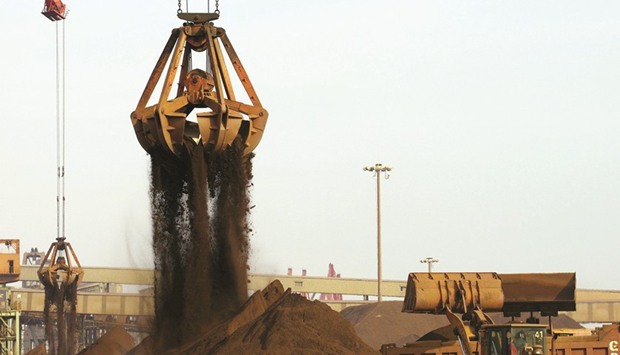Iron ore is getting walloped, over and over again. Prices tumbled, with futures in Singapore plummeting back into the $50s a metric ton, as Citigroup said that it’s bearish on the outlook amid expectations for global oversupply and a slowdown in Chinese steel demand growth.
The most-active SGX AsiaClear contract lost as much as 7.2% to $59.24 a tonne and was at $60.45, set for the lowest close since October 27 and extending the previous day’s 5.8% slump. Futures in Dalian sank 5.1%. Benchmark spot ore with 62% content in Qingdao retreated 4.6% to $63.20 a dry ton, according to Metal Bulletin.
The raw material slumped into a bear market this month amid concern that supplies are rising at the same time that steel prices in China sag, with reinforcement bar and hot-rolled coil sliding to multi-month lows.
The global iron ore surplus was 70mn tonnes last year and that will probably increase by an additional 90mn tonnes this year, according to Citigroup, which flagged more production from Brazil, Australia, China and India. Iron’s latest leg down has come even as China reported positive economic data this week.
“We maintain a bearish view on iron ore and highlight second-half risks, particularly on the slowdown of overall Chinese steel demand growth,” Citi said in a report dated April 17, describing its base-case outlook. The bank sees prices dropping to $60 in the final quarter, and into the $50s in 2018. Iron ore’s sell-off has hurt miners. In London, Rio Tinto Group, BHP Billiton and Anglo American all lost more than 2.5%.
Earlier in Sydney, Fortescue Metals Group fell 7.5%, dropping for a seventh session in the longest losing run in more than three years.
The commodity has sunk after a procession of warnings that the gains through to mid-February were overdone. Among those who flagged the potential for a retreat were Barclays, Capital Economics, Goldman Sachs Group, as well as BHP and the Australian government.
Even favourable Chinese data couldn’t help iron ore. Figures showed Asia’s largest economy accelerated for a second-straight quarter as investment picked up, retail sales rebounded and factory output strengthened. In addition, the country’s mills, which produce half the world’s steel, churned out a record 72mn tonnes in March. Still, the outlook for consumption this month may be less buoyant, according to Maike Futures Co.
“While April is usually the peak period for consumption, steel demand is far weaker than expected,” Maike analysts Ren Jiaojiao and Dang Man wrote in a note on Tuesday. “In the ferrous markets, iron ore probably faces the weakest outlook in the second half.”
Cranes unload imported iron ore from a ship at a port in China. The raw material slumped into a bear market this month amid concern that supplies are rising at the same time that steel prices in China sag, with reinforcement bar and hot-rolled coil sliding to multi-month lows.

IRON


